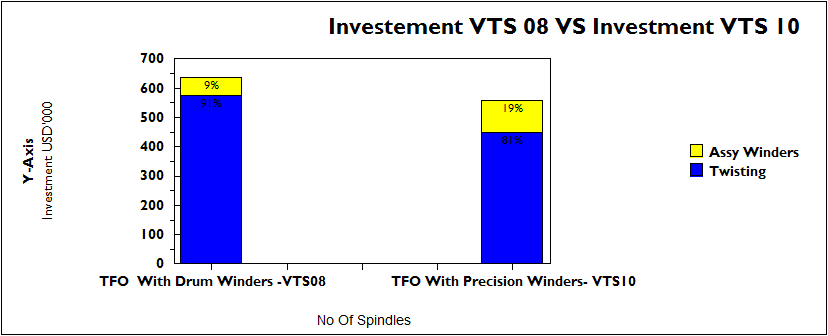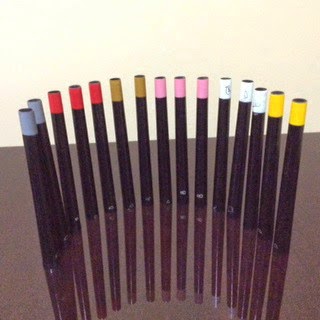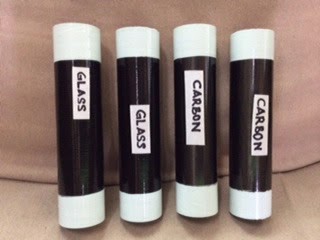Never Twist with a pot dia of more then 120mm again. Kiss the bigger pots a good bye. And if you have larger pots on TFO, time to change the spindle to 120mm pots.
Till now, the 120 mm pot could hold only 850 gms of yarn and hence was non compliant with the market requirement of 1.89kgs cones with one knot.
But this gets resolved with two solutions.
1. Using a Precision Winder to getting a better density of the yarn.
2. Using Carbon Tubes , which shaves off 5 mm thickness of the plastic tubes and give the extra room to give higher content.
Now you can get 1.1 kgs with 38 mm tubes on Precision Winder for 120mm pot diameter. Thereby giving 1.89Kgs++ packages with one knot, which are standard in the market. Though, if you are a little smart, you can get 1.2 kgs knot less on the 38mm tubes, but will need to manipulate the traverse to be around 160mm or a little more.
In fact, it given an opportunity for the machine maker to go down on the spindle size to be only 115mm, with a pot of 120 mm, which will give 950 gms as the pay load.
For Sewing Thread makers, this is a boon. They can take one to one 1200 gms knotless dyepackages directly on the TFO and no need to rewind on soft cone winders.
This practically means, the Investment in TFO project comes down by 25%.
Because, when you use a smaller pot of only 125mm ( VTS 10), the speeds go up by 25%.
Say, if you want to put a plant of 40 TFOs, then one would actually get the same production as that of 150mm pot dia with only 30 TFOs of 125mm pot dia. And not only that, since, the pot is smaller, the operational cost comes down by 20 to 25% . Eg 40 TFOS of 160 mm pot dia will need USD250 per spl x 160 spls per machine x 40 machines = USD1.6 Million. And investments in drum assy winders : USD600 X 160 Spls x 4 machines ( Taking 1 spl of assy winder = 10 spls of Drum winder ) say USD400k. Total of TFO + Assy Winder = USD 2 million.
Now, take a 120 mm pot TFO, the nos of machines required only 30 for exactly the same production : 30 x USD 200 per spl x 160 spls = USD 960K, Plus Precision Assy winder : 4 machines x 100 spindles x USD1600 = USD 640K. Total of USD 960K+ 640k = USD1.6 million Against USD2 million of large pot dia machines. Which is 25% lower overall investement, besides the savings on the knotters, blowers, cables, space etc etc.
Now, if you have 40 TFOs , then all it takes is replacing the pot to 120 mm from , whatever pot size is there on the current TFO, And you sell off 10 machines and from the sales proceeds , fund the conversion of the other 30 machines to 120mm pot .
Power is a function of spindle size and the balloon in TFO. However, one has to find an optimum speeds for power savings as beyond a certain speed the power again goes up exponentially. Therefore, technically though 120 mm pots can go upto speeds of 14500 rpm. But the best speeds would be around 12,500 rpm. Which is still 25 to 30% against the big pots speeds of 9000 rpm.
As per above chart, the total investment comes down by 25%. Infact, the investment in TFO comes down to almost 66% of the original investment. However, one has to invest a little higher into Precision Assembly winders against Drum Winders. If you can get a good deal for the precision winders, then the investement becomes almost 40% lower then the large pot TFO with drum winders.
The savings are
Power savings upto 25%.
Labor saving
Space Saving
Utility Saving
Trolleys, knotters, etc etc
Changing from large pot to 120 mm pot is very simple. Needs only spindle change. However, to get the real deliverable, one needs to have a precision winder or invest into a new precision winder.
This marks the end of Drum Assembly winders and opens the new chapter of small pots for Twisting. However, to get 1 kgs payload on the tube, only would be possible with my tubes. Thereby giving more then 1.89 kgs with one knot.
Till now, the 120 mm pot could hold only 850 gms of yarn and hence was non compliant with the market requirement of 1.89kgs cones with one knot.
 |
| Precision Assembly Winder with Mantex Carbon Tubes |
1. Using a Precision Winder to getting a better density of the yarn.
2. Using Carbon Tubes , which shaves off 5 mm thickness of the plastic tubes and give the extra room to give higher content.
Now you can get 1.1 kgs with 38 mm tubes on Precision Winder for 120mm pot diameter. Thereby giving 1.89Kgs++ packages with one knot, which are standard in the market. Though, if you are a little smart, you can get 1.2 kgs knot less on the 38mm tubes, but will need to manipulate the traverse to be around 160mm or a little more.
In fact, it given an opportunity for the machine maker to go down on the spindle size to be only 115mm, with a pot of 120 mm, which will give 950 gms as the pay load.
For Sewing Thread makers, this is a boon. They can take one to one 1200 gms knotless dyepackages directly on the TFO and no need to rewind on soft cone winders.
This practically means, the Investment in TFO project comes down by 25%.
Because, when you use a smaller pot of only 125mm ( VTS 10), the speeds go up by 25%.
Say, if you want to put a plant of 40 TFOs, then one would actually get the same production as that of 150mm pot dia with only 30 TFOs of 125mm pot dia. And not only that, since, the pot is smaller, the operational cost comes down by 20 to 25% . Eg 40 TFOS of 160 mm pot dia will need USD250 per spl x 160 spls per machine x 40 machines = USD1.6 Million. And investments in drum assy winders : USD600 X 160 Spls x 4 machines ( Taking 1 spl of assy winder = 10 spls of Drum winder ) say USD400k. Total of TFO + Assy Winder = USD 2 million.
Now, take a 120 mm pot TFO, the nos of machines required only 30 for exactly the same production : 30 x USD 200 per spl x 160 spls = USD 960K, Plus Precision Assy winder : 4 machines x 100 spindles x USD1600 = USD 640K. Total of USD 960K+ 640k = USD1.6 million Against USD2 million of large pot dia machines. Which is 25% lower overall investement, besides the savings on the knotters, blowers, cables, space etc etc.
Now, if you have 40 TFOs , then all it takes is replacing the pot to 120 mm from , whatever pot size is there on the current TFO, And you sell off 10 machines and from the sales proceeds , fund the conversion of the other 30 machines to 120mm pot .
Power is a function of spindle size and the balloon in TFO. However, one has to find an optimum speeds for power savings as beyond a certain speed the power again goes up exponentially. Therefore, technically though 120 mm pots can go upto speeds of 14500 rpm. But the best speeds would be around 12,500 rpm. Which is still 25 to 30% against the big pots speeds of 9000 rpm.
 |
| Lower Capital For Same Production |
The savings are
Power savings upto 25%.
Labor saving
Space Saving
Utility Saving
Trolleys, knotters, etc etc
Changing from large pot to 120 mm pot is very simple. Needs only spindle change. However, to get the real deliverable, one needs to have a precision winder or invest into a new precision winder.
This marks the end of Drum Assembly winders and opens the new chapter of small pots for Twisting. However, to get 1 kgs payload on the tube, only would be possible with my tubes. Thereby giving more then 1.89 kgs with one knot.






